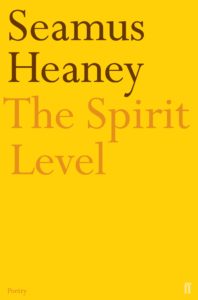Usually when I am reading one of Seamus Heaney’s collections, I use a slip of paper as a bookmark and note the poems that strike me as particularly interesting or effective, so that I can have them fresh in my mind when I write about them for Frumious, or as a guide when I return to the collection. With The Spirit Level I abandoned that practice about a quarter of the way through. I was noting practically every poem. The Spirit Level was published the year after Heaney won the Nobel, and it won the Whitbread Book of the Year, and the quality of this collection shows how deserved both awards were.
The very first lines of the collection —
Upend the rain stick and what happens next
Is a music that you never would have known
To listen for.
— show some of what Heaney is up to. He is giving readers a music they would never have known to listen for. He’s taking a novelty item, the rain stick and capturing both the sensory experience of listening to the stick and its links to greater experiences, the simple wonder of it all.
What happens next
Is undiminished for having happened once,
Twice, ten, a thousand times before.
Is Heaney talking about the sound from the stick, the experience of rain, or the wonder of life itself? Yes.
You are like a rich man entering heaven
Through the ear of a raindrop. Listen now again.
Anyone reading the poem, anyone who has heard a rain stick, or indeed rain, has been improbably given unending gifts. Just pay attention. “Listen now again.”
And so he proceeds through the rest of The Spirit Level. The very next poem, “To a Dutch Potter in Ireland,” links arts, links materials, links conflicts, links people and, by taking a translation as its second part also brings a Dutch poet to Ireland, or at least Heaney’s depiction of Ireland.
Then I entered a strongroom of vocabulary
Where words like urns that had come through the fire
Stood in their bone-dry alcoves next to a kiln
And came away changed.
For most readers of poetry in English, the mention of an urn will bring Keats to mind, and the “strongroom of vocabulary” is like the vast treasury of previous poetry that Heaney can draw on to forge his own, and change them with his creative fire. After this fire, Heaney brings in the other classical elements in the stanzas that follow. “The soils I knew ran dirty. River sand/Was the one clean thing that stayed itself.” He finds something close to the union of these three in Bann clay, “Like wet daylight,” watery earth that’s lit like fire. He says that he and the potter he is addressing — the poem is dedicated to Sonja Landweer — might have known each other in childhood
And might have done the small forbidden things —
Worked at mud-pies or gone too high on swings,
Played ‘secrets’ in the hedge or ‘touching tongues’ —
But did not, in the terrible event.
Landweer’s childhood, from when she was seven to when she was twelve, was marked by the Second World War. The classical element of air enters the poem, location of bombers sent to kill. But Landweer comes through, as Heaney puts it, “Hosannah ex infernis.” The second half of “To a Dutch Potter in Ireland” is a translation of “After Liberation” by J.C. Bloem, who was in his fifties during the war and died just as Heaney was publishing his first collections. Poets and the potter, disparate in ages, linked by events and later by geography.
“Remembered Columns,” a mere two stanzas and eight lines, begins with “The solid letters of the world” and “The marble serifs” taking heavy, seemingly permanent inscriptions and lifts them up through a remembered story “About the Virgin’s house that rose and flew.” The poem’s speaker follows the upward motion “I lift my eyes in a light-headed credo,/Discovering what survives translation true.” The translation here is not just from language to language, but from state to state, from mundane to exalted, from earthly to sublime. And what survives it true? The speaker looks up and finds out. The columns of the title also suggest not only the stone pillars of the first stanza’s images, but the columns of text in the story that the speaker remembers, and the columns of poems that Heaney himself is making.
I stopped at “Remembered Columns” while looking for the poem that contained lines about the spirit level that gave the collection its title. I wanted to talk about the many meanings that Heaney suggests for the name of the tool, the many ideas contained in spirit and level, and all the more in their combination. I had, as mentioned, stopped making notes as I read through the first time. Searching for the phrase, I happened to alight on “Remembered Columns,” but I could have picked practically any poem in The Spirit Level just as profitably. This is a book full of wonders.

